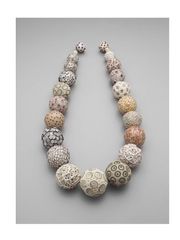Difference between revisions of "Sculpey"
| Line 5: | Line 5: | ||
[Polyform Products, Schiller Park, IL] A brand name for a plasticized [[polyvinyl%20chloride|polyvinyl chloride]] based modeling compound. Sculpey is a polymer clay composed of PVC, plasticizers, coloring agents, and fillers. Original Sculpey comes in a variety of colors and feels like modeling clay but does not dry out until it is oven baked. Sculpey does not shrink when it is baked in the oven and does not crack, shatter, or break easily.<ref> [https://www.sculpey.com/easyfaq/ Sculpey FAQs: Polymer Clay Basics] </ref> | [Polyform Products, Schiller Park, IL] A brand name for a plasticized [[polyvinyl%20chloride|polyvinyl chloride]] based modeling compound. Sculpey is a polymer clay composed of PVC, plasticizers, coloring agents, and fillers. Original Sculpey comes in a variety of colors and feels like modeling clay but does not dry out until it is oven baked. Sculpey does not shrink when it is baked in the oven and does not crack, shatter, or break easily.<ref> [https://www.sculpey.com/easyfaq/ Sculpey FAQs: Polymer Clay Basics] </ref> | ||
| − | Sculpey contains about 15% di-(2-ethylhexyl) terephthalate (DOTP) plasticizer. Prior to 1991, it contained [[dioctyl%20phthalate|di-(2-ethylhexyl) phthalate]] (DEHP) which is now listed as a carcinogen. <ref> [https://www.culturalheritage.org/docs/default-source/periodicals/acts_facts_1994_vol8.pdf?sfvrsn=2 ACTS FACTS 1994: Oven-Cured Polymer Clays] </ref> The soft, uncured Sculpey should not be placed on painted or varnished surfaces as the plasticizer will dissolve these materials. Additionally, uncured Sculpey may be affected by solvent based paints. Sculpey instructions recommend baking at temperatures below 130C (275F). After baking, the material solidifies and can be sanded, drilled, carved, or painted. < | + | Sculpey contains about 15% di-(2-ethylhexyl) terephthalate (DOTP) plasticizer. Prior to 1991, it contained [[dioctyl%20phthalate|di-(2-ethylhexyl) phthalate]] (DEHP) which is now listed as a carcinogen. <ref> [https://www.culturalheritage.org/docs/default-source/periodicals/acts_facts_1994_vol8.pdf?sfvrsn=2 ACTS FACTS 1994: Oven-Cured Polymer Clays] </ref> The soft, uncured Sculpey should not be placed on painted or varnished surfaces as the plasticizer will dissolve these materials. Additionally, uncured Sculpey may be affected by solvent based paints. Sculpey instructions recommend baking at temperatures below 130C (275F). After baking, the material solidifies and can be sanded, drilled, carved, or painted. <ref>[https://www.sculpey.com/easyfaq/ Sculpey FAQs] </ref> |
== Synonyms and Related Terms == | == Synonyms and Related Terms == | ||
Revision as of 13:11, 21 July 2020
Description
[Polyform Products, Schiller Park, IL] A brand name for a plasticized Polyvinyl chloride based modeling compound. Sculpey is a polymer clay composed of PVC, plasticizers, coloring agents, and fillers. Original Sculpey comes in a variety of colors and feels like modeling clay but does not dry out until it is oven baked. Sculpey does not shrink when it is baked in the oven and does not crack, shatter, or break easily.[1]
Sculpey contains about 15% di-(2-ethylhexyl) terephthalate (DOTP) plasticizer. Prior to 1991, it contained di-(2-ethylhexyl) phthalate (DEHP) which is now listed as a carcinogen. [2] The soft, uncured Sculpey should not be placed on painted or varnished surfaces as the plasticizer will dissolve these materials. Additionally, uncured Sculpey may be affected by solvent based paints. Sculpey instructions recommend baking at temperatures below 130C (275F). After baking, the material solidifies and can be sanded, drilled, carved, or painted. [3]
Synonyms and Related Terms
modeling clay; Sculpy (sp); polymer clay; oven-bake clay; oven hardening clay
Applications
Exhibit
Personal Risks
Do not inhale fumes while baking. Overheating in the oven will result in blackening and release of irritating gases including hydrogen chloride vapor (polyvinyl chloride decomposes at 190°C/375°F).
Polyform: SDS
Additional Information
Sculpey: [Website]

